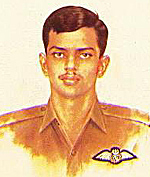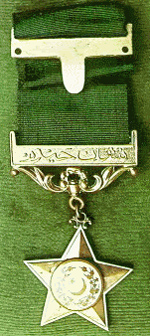 In the year 1971, a civil war was raging in East Pakistan ( modern day
Bangladesh ). Almost all the Bengali soldiers serving in West Pakistan (
modern day Pakistan ) deserted their posts and rank due to their
nationalistic feelings towards East Pakistan. These soldiers stole
the secret plans of Pakistan Army, Air Force and Navy and presented them to
the Indians and to the Mukti Bahini, which was the Bangladesh Seperatist
Militant Movement.
In the year 1971, a civil war was raging in East Pakistan ( modern day
Bangladesh ). Almost all the Bengali soldiers serving in West Pakistan (
modern day Pakistan ) deserted their posts and rank due to their
nationalistic feelings towards East Pakistan. These soldiers stole
the secret plans of Pakistan Army, Air Force and Navy and presented them to
the Indians and to the Mukti Bahini, which was the Bangladesh Seperatist
Militant Movement.
On the 20th of August, 1971, three Pakistan Air Force (PAF) pilots were to take their T-33 planes on test flights as part of their training at the Pakistan Air Force Masroor Base near Karachi. The T-33 "T-Bird" plane was a fighter trainer aircraft. It had two cockpits, and both of the cockpits have controls over the plane. The instructor pilot uses the controls in the rear cockpit to correct the mistakes of the student pilot and to take full control if something goes seriously wrong. But in these training flights the instructor was not going to sit in the rear cockpit of these three planes.
By 11:25 a.m. two of the planes had taken off. At 11:26 a.m., the 20 year old pilot of the third T-33 plane, Rashid Minhas, received clearance from the control tower to take off. While he was moving his plane in take-off position, Safety Flight Officer Muti-ur-Rehman, one of the best pilot instructors at that P.A.F Base, gave the danger signal. The danger signal was used primarily to identify a technical problem with the aircraft, and so Rashid Minhas stopped his plane.
Muti-ur-Rehman Strikes
He opened the cockpit and stood up to ask what had gone wrong. Due to the strong noise created by the aircraft engines, pilots and technicians usually come close to one another to talk. And so Minhas allowed the instructor to come close to him, and while he was preparing to ask him about the possible technical difficulty, Muti-ur-Rehman got hold of him and rendered him partially unconscious using a chloroform sprayed handkerchief.
Once Rashid was down, the instructor called a couple of his partners and said, "I am going to Jodhpur (India). You pick up my family and go to the Indian High Commission in Karachi. Take refuge there".
Muti-ur-Rehman's selection of Rashid was perhaps not by chance. He had perhaps narrowed down on his options by first selecting the group of pilots who had lesser knowledge and experience with flying ( the Pilot Officers ) and then from those pilots, he selected the one who appeared to be physically the weakest. Himself a well built man, and a brilliant pilot, his plan was accurate and under the circumstances the odds were much in Muti-ur-Rehman's favor.
At 11:29 a.m., as Muti-ur-Rehman ignited the plane and prepared to take-off, the semi-conscious Minhas contacted the control tower and told them that he is being kidnapped. He told them that they should stop the partners of Muti-ur-Rehman from getting to the Indian High Commission. Two minutes later the ground control tower replied that he must try and stop the plane from being skyjacked.
Skyjacked
But the plane took-off at 11:31, 40 seconds after the control tower had given the orders to Minhas. Despite the fact that Muti was armed, the drugged Minhas tried to fight with him. The efforts , however, were in vain as Muti-ur-Rehman was too strong for him. By 11:33 a.m., the planes communication with the control tower was broken and Minhas was on his own in dealing with the strong and armed Muti. Rashid's last standing orders were to stop the plane from being skyjacked.
The P.A.F. Masroor base sent out some planes to look for the skyjacked T-33A. The P.A.F radars were fully operational trying to look for the exact coordinates of the plane but were unable to find the plane. How was this possible? How could a plane, which had been hijacked 20 minutes ago not be detected on P.A.F's radars.
 The answer was that Muti was flying the T-33 at 30 to 40 feet above the ground which was too low for the radars. The P.A.F planes searching for the skyjacked T-33 were looking thousands of feet above the ground.
The answer was that Muti was flying the T-33 at 30 to 40 feet above the ground which was too low for the radars. The P.A.F planes searching for the skyjacked T-33 were looking thousands of feet above the ground.
The brave Rashid didn't eject, nor did he come to any financial understanding with his instructor. He also did not stand down in face of a gun or the physical strength of his foe. He kept trying to take controls, but Muti, having the instructor's controls ,would always bring the plane back on course. Rashid's last orders were to stop the plane from being skyjacked. He had run out of all options but one.
Rashid Minhas delibrately turned the direction of the plane towards the earth. Muti tried to override this action but it was too late. The plane crashed into the ground and blew up immediately killing Rashid Minhas and Muti-ur-Rehman.
Rashid Minhas did not bow down to adversity, but instead he stood up to it very bravely and did his full duty keeping the proud traditions of the P.A.F. For this act of heroism above and beyond the call of duty, Rashid Minhas was awarded the Nishan-i-Haider (at right), Pakistan's highest medal for gallantry.
Bibliography
Hussain, Shabbir: History Of The Pakistan Air Force 1947-1982: PAF Press, Karachi, 1982.
Back to Table of Contents -- Pakistan At War Newsletter 4
Back to Pakistan At War Newsletter List of Issues
Back to MagWeb Magazine List
© Copyright 2002 by Shahram Khan.
This article appears in MagWeb (Magazine Web) on the Internet World Wide Web.
Other military history articles and gaming articles are available at http://www.magweb.com